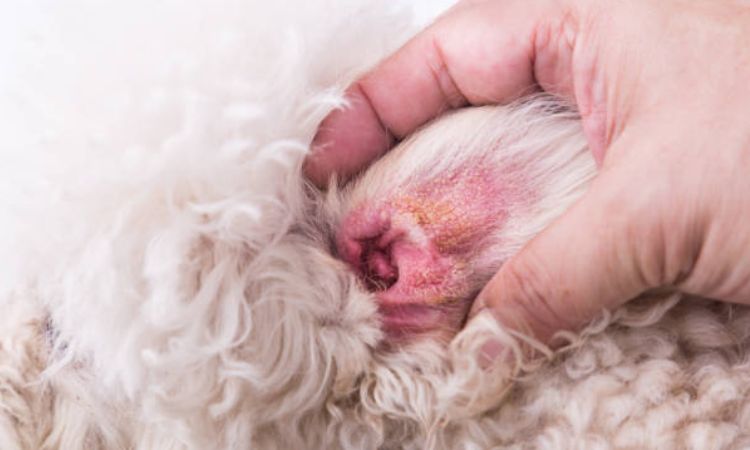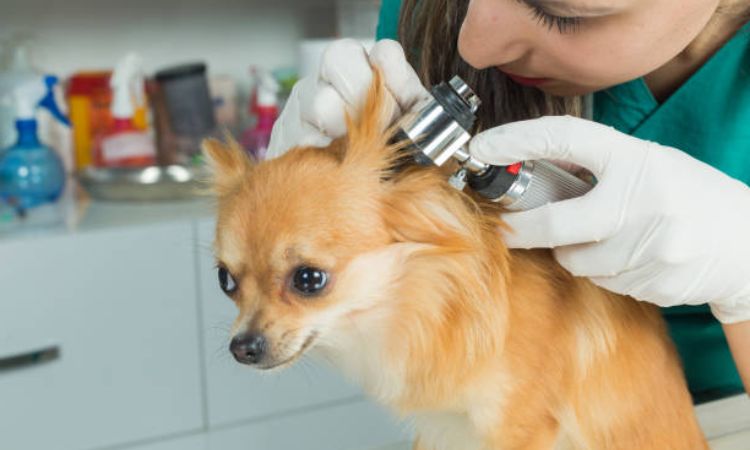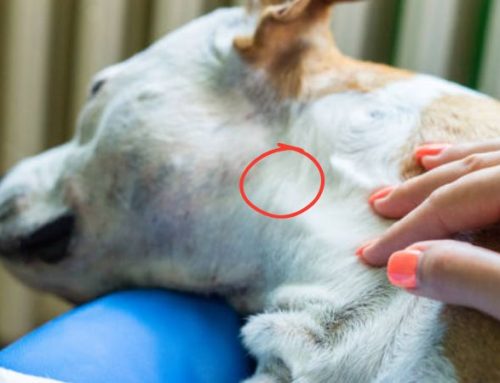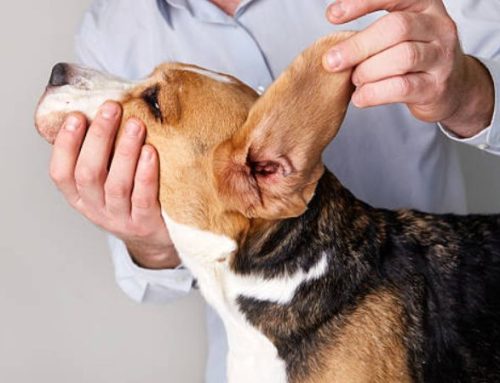Dogs with long, floppy ears are especially prone to ear infections, and if you’ve noticed your pup scratching, shaking their head, or showing signs of discomfort, you’re not alone. These issues are more common than you might think—but the good news is, they’re also highly treatable.
At Nexus-pets we’re here to guide you through the most effective ways to treat dog ear infections, from gentle at-home care to professional veterinary solutions.

Home Remedies for Dog Ear Infections
While veterinary care is essential for moderate to severe ear infections, certain home remedies can offer support in mild cases or help maintain ear health between vet visits. Always consult your veterinarian before beginning any at-home treatment, especially if your dog is already showing signs of discomfort or infection.
Ear Cleaning Basics
Routine ear cleaning helps remove debris, prevent wax buildup, and minimize the risk of infection. However, it’s important to clean only when necessary, as over-cleaning can irritate the ear canal.
- When to Clean: Clean your dog’s ears if they appear dirty, after swimming, or if recommended by your vet. Avoid cleaning red, inflamed, or painful ears without professional advice.
- How to Clean Safely: Use a soft, clean cloth or gauze and a vet-approved ear cleaning solution. Gently lift the ear flap, apply the solution into the ear canal, and massage the base of the ear for 20–30 seconds to loosen debris. Let your dog shake its head, then wipe away any visible residue.
- Avoid: Cotton swabs (Q-tips), alcohol, and harsh chemicals, as these can push debris deeper or cause irritation.
Apple Cider Vinegar Solution
Apple cider vinegar (ACV) is a natural remedy known for its antibacterial and antifungal properties, making it a popular choice for addressing minor infections and yeast buildup.
- Preparation: Mix equal parts raw, unfiltered apple cider vinegar and distilled water in a clean container.
- Application Tips: Soak a cotton ball in the diluted solution and gently wipe only the outer parts of the ear. Avoid pouring ACV directly into the canal, especially if the skin is broken or inflamed, as it can sting.
- Benefits: ACV helps rebalance the pH of the ear environment and inhibits the growth of bacteria and yeast.
Coconut Oil
Coconut oil contains lauric acid, which gives it strong antimicrobial and anti-inflammatory properties. It can soothe irritation and reduce mild infections when applied correctly.
- Application: Warm the coconut oil slightly until it’s liquid (not hot). Using a dropper or clean finger, apply a small amount around the entrance of the ear canal, then gently massage the base of the ear.
- Frequency: Use once daily for up to a week for minor irritation. Discontinue use if symptoms worsen or persist.
- Note: Make sure your dog doesn’t have an allergy to coconut products before using.
Witch Hazel
Witch hazel acts as a natural astringent that can help dry out excess moisture and reduce swelling in the outer ear.
- Use: Moisten a cotton pad with alcohol-free witch hazel and gently wipe the ear flap and surrounding area.
- Caution: Do not use if the skin is broken or irritated. Avoid pouring witch hazel directly into the ear canal.
- Benefit: Especially useful after swimming to keep the outer ear dry and less prone to infection.
Hydrogen Peroxide
Though often used in cleaning wounds, hydrogen peroxide must be used cautiously on dogs’ ears.
- Dilution: Mix a 3% hydrogen peroxide solution with an equal part of distilled water.
- Safe Use: Use only for surface cleaning—apply with a cotton ball around the outer ear. Never pour directly into the ear canal.
- Risks: Overuse can disrupt healthy bacteria and damage sensitive ear tissue, so limit use to occasional cleaning under veterinary guidance.
Other Natural Remedies
Several other natural treatments are being explored for ear health, with anecdotal support and emerging research.
- Calendula Tincture: Known for its healing and anti-inflammatory qualities, diluted calendula can be used topically to soothe minor irritation.
- Grapefruit Seed Extract: Often used in small doses for its antimicrobial action; must be heavily diluted.
- Oil of Oregano: A potent natural antifungal, though it can be irritating and should only be used when properly diluted and approved by a vet.
- CBD Oil & Silver Hydrosol: These emerging options show promise for anti-inflammatory and antibacterial benefits but should only be used under veterinary supervision.
Keeping Ears Dry
Moisture is a major contributor to ear infections, particularly for dogs who swim or bathe often.
- Drying Tips: After any water exposure, gently dry your dog’s outer ears with a towel. Use ear-drying drops (available over the counter or from your vet) to prevent trapped moisture.
- Prevention Focus: Always dry ears thoroughly after bathing or swimming and avoid letting water get into the ear canal. Keeping the ear environment dry discourages yeast and bacteria growth.
When used properly, these natural remedies can support your dog’s ear health and help manage mild symptoms. However, they should never replace professional veterinary care in moderate or severe cases. Regular monitoring and prompt action remain key to protecting your dog’s hearing and comfort.

When to See a Veterinarian
While home remedies can help with mild or early-stage ear issues, there are clear signs that your dog needs professional medical attention. If symptoms persist or worsen, delaying treatment may lead to serious complications.
Signs That Home Remedies Aren’t Enough
If your dog’s ear infection doesn’t improve within a few days of using gentle, at-home care, it’s time to consult your veterinarian. Warning signs include:
- Persistent symptoms like redness, discharge, or head shaking lasting more than 3–5 days
- Severe pain, visible swelling, or bleeding in or around the ear
- Foul odor or thick, dark discharge indicating infection
- Cuts, wounds, or visible foreign objects in the ear canal
- Behavioral changes such as lethargy, irritability, or loss of appetite
These signs may point to a more serious underlying issue that home treatment cannot resolve.
What to Expect at the Vet
A veterinarian will begin with a physical ear examination, using an otoscope to check for blockages, inflammation, or damage inside the ear canal. In many cases, your vet will perform cytology, a microscopic analysis of ear discharge, to identify the presence of bacteria, yeast, or mites.
Further testing may include:
- Culture and sensitivity tests to determine which medications will work best
- Allergy testing if infections are recurring and linked to skin issues
- Imaging (such as X-rays) for chronic or complicated infections
Veterinary Treatment Options
Treatment depends on the specific cause of the infection. Common options include:
- Topical antibiotics or antifungal medications for bacterial or yeast infections
- Oral antibiotics for severe or chronic cases
- Steroids or anti-inflammatories (used with caution) to reduce swelling and discomfort
- Ear flush or deep cleaning under sedation in more advanced cases
Your vet may also prescribe medicated ear drops containing a combination of ingredients to address infection, inflammation, and itching.
Possible Side Effects and Risks of Medications
While most prescribed treatments are effective and safe, some dogs may experience side effects such as:
- Gastrointestinal upset from oral antibiotics
- Ear canal irritation or allergic reaction to topical drops
- Long-term steroid use leading to immune suppression or skin thinning
Always follow your vet’s dosage instructions and report any unusual behavior or worsening symptoms promptly.
Treating the Root Cause
It’s essential not to just treat symptoms, but to uncover the underlying cause—whether it’s allergies, hormonal imbalances, ear mites, or foreign objects. Without addressing the root issue, ear infections may keep returning. Your veterinarian can create a long-term management plan tailored to your dog’s specific needs.

Preventing Future Ear Infections
Preventing ear infections in dogs starts with regular ear care. Clean your dog’s ears using a vet-approved solution and a soft cloth, especially after swimming or bathing. Avoid inserting anything deep into the ear canal.
Manage moisture and allergies—two common triggers. Keep ears dry and monitor for signs of irritation caused by food or environmental allergens. If allergies are suspected, consult your vet for testing or dietary adjustments.
Schedule regular vet check-ups, especially for dogs prone to infections. Early detection and consistent care can greatly reduce the risk of recurring problems.
For your dog’s ear health, prompt veterinary care is almost always essential for true infections, far beyond what home remedies can achieve. Don’t hesitate to see your vet; their expertise ensures effective treatment and prevents minor issues from becoming painful, chronic conditions. Proactive care keeps your furry friend healthy and happy!






